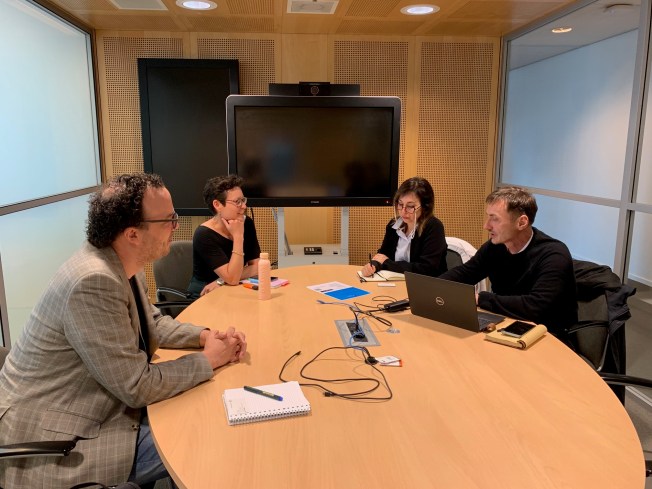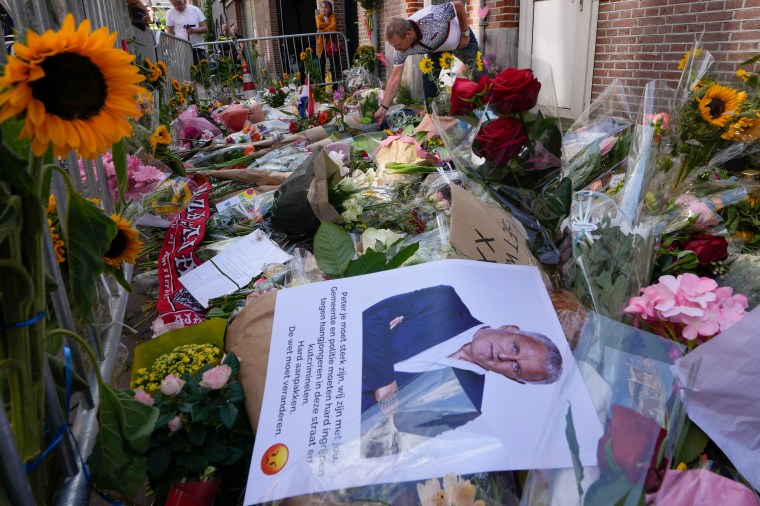On a small street off Amsterdam’s bustling museum district, there is no indication of the 2021 event seared into the memories of the Dutch press corps – at least not yet. Authorities have plans to build a memorial near the site where crime reporter Peter R. de Vries was shot on July 6 after leaving a TV studio where he was a frequent guest speaker. He fell into a coma and died nine days later at a nearby hospital.
De Vries’ killing was the most serious attack on journalist safety in a country where press freedom has long been taken for granted. In today’s Netherlands, journalists covering protests have been attacked by demonstrators – and occasionally detained by police — and face a torrent of online harassment. Combined with threats to crime reporters amid a rise in illegal drug trafficking, such incidents have dimmed the reputation of the Netherlands – along with other countries in the European Union – as one of the world’s safest places for journalists.
On a fact-finding and advocacy mission to the Netherlands from June 26 to 30, CPJ met with journalists, press freedom advocates, experts, and government officials about ways to keep journalists safe in an increasingly hostile media climate.
Key takeaways from CPJ’s visit:
De Vries’ killing has had ripple effects
At a café just a few blocks away from the site of de Vries’ killing, crime reporter Paul Vugts spoke to CPJ about his close colleague. Authorities believe de Vries was targeted for his role as an adviser and spokesperson for a witness in the trial of a drug kingpin rather than for his reporting, an assessment with which Vugts agrees. But he says that the killing has impacted Dutch journalism nonetheless.
“It had a chilling effect on journalists. Experienced crime reporters continue publishing. I do. But I let the police know in advance. That’s new. I wouldn’t do so before,” said Vugts, who was the Netherlands’ first journalist to go under full police protection because of death threats due to his work.

Before de Vries was killed, he had been outspoken about receiving threats due to his connection to the witness, whose brother and lawyer were also killed. The journalist, however, was not under police protection, according to Vugts and another local journalist with knowledge of the case.
Vugts said de Vries was negotiating a kind of modified protection with law enforcement as he believed full-scale protection offered to witnesses would hamper his ability to meet with sources. De Vries’ lack of protection at the time of his death sparked criticism and calls from local and international press freedom groups for better safety measure for the press.
“The killing shocked the Dutch society as a whole. It was by perceived by many as an attack on a journalist, and as an attack on the rule of law,” said Guusje Somer, policy and advocacy officer at the Amsterdam-based journalist rights group Free Press Unlimited. “It sent a message to show the power of organized crime and has a clear chilling effect on journalism in the Netherlands.”
Meanwhile, the crime remains unsolved despite authorities’ arrest of two suspects within an hour of the shooting. The case was delayed after prosecutors submitted new evidence, and then again after a judge resigned. The trial will continue in early 2024; there are now a total of nine suspects.
The Dutch government plans to improve protections for journalists
The de Vries killing was the most serious, but hardly the first, incident of its kind in the Netherlands. In 2016, Martin Kok, a convicted killer who wrote about crime on his blog, was killed in a gang-related attack. In 2018, an anti-tank missile was fired at the offices of the publisher of weekly newspapers Panorama and Nieuwe Review; two days later an attacker crashed a van into the headquarters of the daily newspaper De Telegraaf and set the vehicle on fire. While investigators did not establish formal links to criminal gangs in the newspaper attacks, prosecutors suspected a connection to the outlets’ coverage of organized crime.
“The fear among crime reporters is that now everything is possible, no one is safe,” Yelle Tieleman, an investigative journalist, told CPJ in an interview in Amsterdam. Tieleman said that Dutch crime reporters have always walked a fine line between publishing scoops about gangs and navigating potential blowback. After this series of attacks, “this line has become even finer,” he said. Some journalists are self-censoring and other reporters, in particular freelancers without institutional support, have abandoned crime reporting altogether.
A recent study commissioned by the Ministry of Justice found that crime reporting has become more dangerous, with gangs showing an increased willingness to resort to deadly force in order to suppress information or express dissatisfaction with certain publications. In response, the government has been working on a comprehensive overhaul of the protection system provided to individuals threatened by organized crime, including journalists, lawyers, and prosecutors, the specifics of which have yet to be released.
Vugts welcomed these efforts, calling the current system “top-down and rigid” and ill-equipped to handle the increasing number of individuals facing threats. He said the government must allocate resources and solutions tailored to journalists so they can continue reporting on crime, even under police protection. “We are not in a narco-state, here the state is working to provide a better system of protection,” he said.
Crime reporters aren’t the only ones at risk
The growing risks to crime reporters reflect an increasingly hostile environment for journalism in the Netherlands. Linda Bos, a communications professor at the University of Amsterdam told CPJ that the rising populism and deepening polarization have fueled anti-establishment sentiments and conspiracy theories. “The pandemic has only further highlighted this trend” due to skepticism around vaccines, she said. This has impacted journalists, who are broadly perceived as part of the establishment.
A survey by PersVeilig or “PressSafe,” a joint initiative of journalists unions, media, police, and prosecutors, showed a sharp uptick in threats to journalists between 2017 and 2021, including incidents of verbal aggression, physical assaults, intimidation, and legal harassment. Two-thirds of journalists experienced verbal aggression at least once in the year before the survey was conducted in 2021, while 17% were exposed to physical aggression. Women journalists and those from minority groups or immigrant backgrounds are at greater risk.

The rise in hostile attacks prompted NOS, the country’s public broadcaster, to remove its logos from the company’s vehicles and equipment to better protect staff. Some outlets have also resorted to hiring safety personnel to accompany their crews during protests.
In addition, tensions between journalists and the police during demonstrations have made it harder for the media to cover civil unrest. Police must make on-the-spot decisions to identify journalists, and at times have lumped them in with protesters, arresting them or forcing them to leave demonstrations.
When CPJ met the police representatives in The Hague, they were preparing for a farmers’ protest expected the following day. Officers and members of the communications team told CPJ that the police were committed to ensuring safety of journalists covering protests, and riot police were provided with information and training on identifying members of the press.
The Netherlands’ Union of Journalists’ (NVJ) head Thomas Bruning told CPJ that police are indeed committed to ensuring press access to protests, but don’t have the resources to ensure officers on the ground follow such guidelines. “There’s a willingness of police to train their forces on press cards and rights of journalists but they don’t have sufficient training capacity,” he said. NVJ has tried to fill the gap with its own police trainings “but it has been ad-hoc. A more systemic, regular approach is needed,” he said.
Dutch journalists are harassed online
Online harassment is also a press freedom issue in the Netherlands. Another PersVeilig survey showed that nearly 82% of 300 surveyed women journalists said they had been subject to online harassment, threats, and intimidation on various tech platforms. Nearly a quarter of the incidents occurred on X (formerly Twitter), which Bos called “the main platform of hate.”
CPJ met with Peter ter Velde, the head of PersVeilig in his office in central Amsterdam. He told CPJ that he and representatives of media organizations have met with tech companies including Google and Meta to raise the issue of harassment on their platforms but had not yet been able to meet with X. PersVeilig, which shares an office with the journalists’ union, is keenly aware of how the issue affects women; it recently hired a woman to field harassment complaints from female journalists who might feel uncomfortable reporting them to a man. Ter Velde also said that the police are trying to address the issue. They are “on board,” he said, but “lack capacity to look into all cases of online harassment.”
Pieter van Koetsveld and Charlotte Wolf, of the Ministry of Education, Culture, and Science’s directorate in charge of liaising with journalists, told CPJ in a meeting that online harassment is a priority for the ministry. They pointed to their department’s funding of PersVeilig as evidence of their commitment.

“Our Ministry identified journalists as a vulnerable group who need our support and we have plans to support them,” Wolff said. Koetsveld said that the ministry has been in touch with Google on the issue of online harassment of journalists, but not with X.
PersVeilig provides hope to journalists
PersVeilig has been hailed by press freedom organizations as an international model for building bridges between journalists, law enforcement, and prosecutors in order to keep journalists safe so they can do their jobs. When ter Velde, a former journalist who covered wars and conflicts, agreed to head PersVeilig after its founding in 2019, it helped the organization gain trust in the Dutch journalism community.
In addition to hosting safety trainings and detailing security protocols, PersVeilig operates a hotline and a dedicated online platform where journalists can report threats and receive guidance on filing complaints with the police. One of PersVeilig’s biggest achievements is that it secured commitments from police and prosecutors to prioritize investigating attacks on journalists by opening a rapid criminal investigation when one occurs. Prosecutors have also committed to increasing punishments for attacks on journalists, ter Velde said.
Ter Velde told CPJ that journalists know and trust the organization, but that its work is “vulnerable” so long as he is the only employee. Ter Velde plans to hire one more staffer, with the hopes of expanding further in the future to focus on the security needs of female journalists and on legal threats.
“When we started PersVeilig, we thought it’d continue for three years. But the country has changed. Organized crime has changed – there are no red lines, no boundaries for them as Peter’s killing demonstrated,” he said. “Journalists need more help than ever before.”
Editor’s note: The eighth paragraph has been updated with additional details from Guusje Somer.
